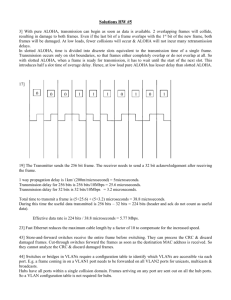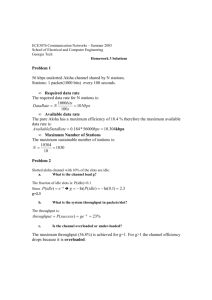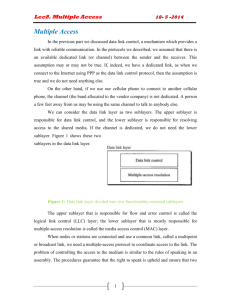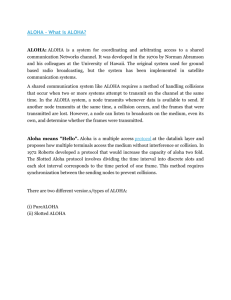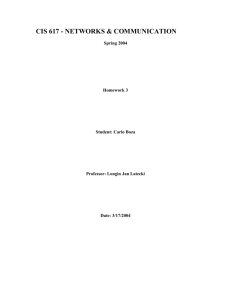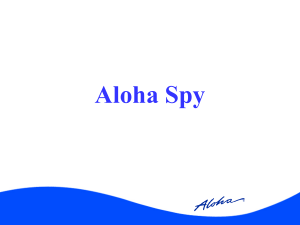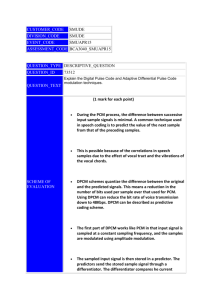JineshSanghvi5Q
advertisement
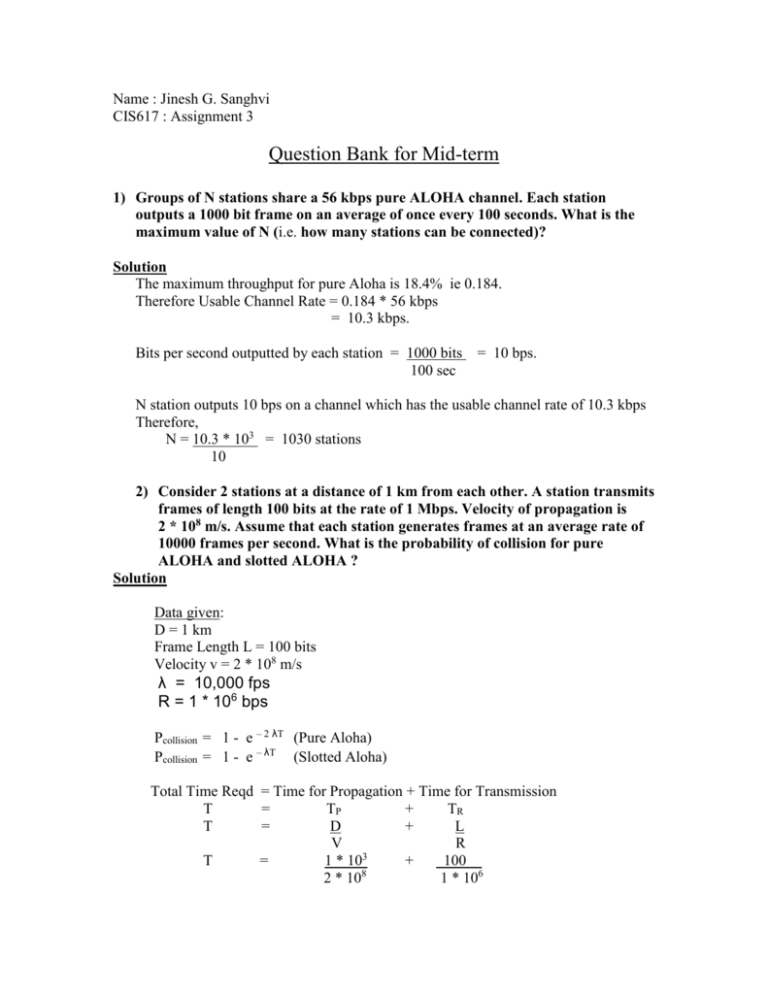
Name : Jinesh G. Sanghvi CIS617 : Assignment 3 Question Bank for Mid-term 1) Groups of N stations share a 56 kbps pure ALOHA channel. Each station outputs a 1000 bit frame on an average of once every 100 seconds. What is the maximum value of N (i.e. how many stations can be connected)? Solution The maximum throughput for pure Aloha is 18.4% ie 0.184. Therefore Usable Channel Rate = 0.184 * 56 kbps = 10.3 kbps. Bits per second outputted by each station = 1000 bits 100 sec = 10 bps. N station outputs 10 bps on a channel which has the usable channel rate of 10.3 kbps Therefore, N = 10.3 * 103 = 1030 stations 10 2) Consider 2 stations at a distance of 1 km from each other. A station transmits frames of length 100 bits at the rate of 1 Mbps. Velocity of propagation is 2 * 108 m/s. Assume that each station generates frames at an average rate of 10000 frames per second. What is the probability of collision for pure ALOHA and slotted ALOHA ? Solution Data given: D = 1 km Frame Length L = 100 bits Velocity v = 2 * 108 m/s λ = 10,000 fps R = 1 * 106 bps Pcollision = 1 - e – 2 λT (Pure Aloha) Pcollision = 1 - e – λT (Slotted Aloha) Total Time Reqd = Time for Propagation + Time for Transmission T = TP + TR T = D + L V R T = 1 * 103 + 100 2 * 108 1 * 106 . T = 105 * 10-6 sec Pcollision = 1 - e – 2 4λT (Pure Aloha) 2*10 *105*106 = 1 e = 1 – e-2.1 = 0.88 Pcollision = 1 - e – λT = 1 – e-1.05 = 0.65 (Slotted Aloha) 3) A large population of ALOHA users generates 50 request/sec . Time is slotted in units of 40msec. a. What is the chance of success on the first attempt. b. What is the probability of exactly k collisions and then a success. c. What is the expected number of transmission attempts needed. d. What is the channel load G. Solution T = 40 msec = 0.04 sec λ = 50 req/sec = 50 frames/sec a. Success on the first attempt means there is no collision Po = e- λT = e-2 b. Probality of K collisions = Pkcollision = (1 eT ) k Therefore, Probablity of K collisions followed by a success = (1 eT ) k * e- λT Preqd = (1 – e-2)k * e-2 = (0.865)k * 0.135 C. Expected number of transmission = 1 Pnocollision = e2 = 7.387524 d. Channel load G = λT = 2 request ie 2 frames per second . The valid frame length must be at least 64 bytes long so as to prevent a station from completing the transmission of a short frame before the first bit has even reached the far end of the cable, where it may collide with another frame. How is the minimum frame length adjusted if the network speed goes up. Solution As the network speed goes up, the minimum frame length must go up or the maximum cable length must come down, proportionally so that the sender does not incorrectly conclude that the frame was successfully sent in case of collision. 4. 5. What are local addresses and global addresses and how are they distinguished from each other. How many global addresses can be at the most available if the Mac addresses is 6 bytes long? Solution Local addresses are assigned by the network administrator and have no significance outside the local network. Global addresses, in contrast, are assigned centrally by IEEE to ensure that no stations anywhere in the world have the same global address. Since the Mac addresses are 6 bytes long ie 48 bits. The higher order bit of the destination address, bit 47 is either 0 or 1. 0 is for ordinary address and 1 is for group address. Bit number 46(the bit adjacent to higher order bit 47) is used to distinguish between local and global addresses. With 48-2 = 46 bits available, there are about 7 * 103 global addresses available.
